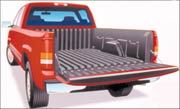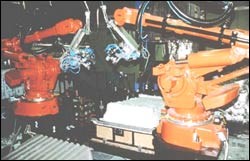SRIM: Material, Machine & Process Innovations Give Birth to SRIM Truck Box
Automotive use of high-density structural RIM (HD-SRIM) technology has progressed from its beginnings in bumper beams to full-size pickup-truck boxes and tailgates.
Automotive use of high-density structural RIM (HD-SRIM) technology has progressed from its beginnings in bumper beams to full-size pickup-truck boxes and tailgates. Improved polyurethane chemistry, robotic preforming technology, and refinements of molding technique all helped make possible commercial production of these large, complex structural parts. Here, for the first time, are the details on the technical developments behind this project.
In mid-2001, two years after it was first announced, General Motors began offering “Protec,” a new 6.5-ft-long, SRIM-composite box and tailgate system as an option on the full-size Chevrolet Silverado pickup truck. A thousand units were produced and sent to dealers by the end of 2001. As for this year’s planned production, company spokesmen said only that GM is prepared to build “whatever the market demands.”
The SRIM composite truck box has been a joint effort between General Motors and polyurethane supplier Bayer Corp. in Pittsburgh; fiberglass supplier Owens Corning in Toledo, Ohio; machinery producer Cannon USA in Cranberry Township, Pa.; and Tier 1 molder and assembly provider Meridian Automotive Systems in Huntington, Ind.
As opposed to a traditional steel box with a thermoformed plastic bed liner, the entire Protec unit is made of composite materials. The box’s fenders and outer tailgate panel are made of reinforced RIM (RRIM), primarily polyurea with mica filler. The one-piece box and the inside of the tailgate are SRIM composites of urethane with 50% long glass fiber. The interior of the box and tailgate are coated with a black “spatter paint” that provides a tough, pebbly surface and uv protection. Use of SRIM and RRIM composites reduces the total vehicle weight by about 50 lb. The tailgate alone is 15 lb lighter than a steel version.
Automated preforming
The robotic preforming system used by Meridian was built by Cannon in Italy and is based on a modified version of the “P4” system (Programmable Powdered Preform Process) developed by Owens Corning in the early 1990s. The main change is the use of a new glass reinforcement and “string binder” system that Owens Corning calls Preformable Roving.
This new roving system contains binder-coated strands commingled with the glass reinforcement, explains Owens Corning project leader Thomas Miller. The “string binder” strands are a pre-catalyzed thermosetting polyester binder coated onto a glass carrier fiber. When heated in the preform curing operation, the binder first melts onto surrounding glass fibers and then cures and hardens. The roving contains 5% binder by weight.
The truck-box preform is made by feeding four glass roving strands into a robot arm with a chopper head. Meridian uses four robots, each with two choppers, to lay down the rovings. Thus, a total of 32 roving strands are chopped into the preform.
Launch-team coordinator Gene Symosko of Bayer’s technical service dept. says the choppers cut the rovings to a 3-in. length and drop them onto a metal screen that is the same size and shape as the finished truck box. According to Meridian project engineer Pat DePalma, one chopper can deposit 4.4 lb/min of glass on the screen.
Air drawn through the screen’s perforations holds the glass against the surface. The screen then rotates into a 500 F oven to cure the binder. Cycle time for preforming is around 3 min. This compares with 8 min using a conventional chopped-glass preforming process.
Meridian’s DePalma says the “string binder” technology eliminates problems encountered previously in SRIM preforming with aqueous emulsion binders that were messy to handle and gave less uniform results. Bayer’s Symosko adds that preform weight variation is well under 10%, compared with 20% in preforms made with conventional technology. He attributes this to both the robot control technology and the new binder.
‘Squeeze-molding’ process
Once the cured preform comes out of the oven, a robot automatically moves it from the preform screen to a holding station. From there, the preform is manually placed over the core of the 5 x 6 ft SRIM mold.
The PUR composite part is made by injection-compression or “squeeze-molding.” The injection equipment is a conventional metering machine used in RRIM fascia production, Cannon’s HE180 lance-cylinder unit.
The compression press is a 2000-ton Dieffenbacher SMC press that was retrofitted for PUR processing. The main modification is the inclusion of a shuttle bed. Shuttling the core out of the mold allows the preform to be positioned on the mold with maximum operator safety. Once the preform is in place, the shuttle moves back into the press and the top mold half drops down onto the preform surface, but the mold is left open 0.5 in.
The RIM machine pours the liquid onto the preform. Once the 35- to 40-lb shot is complete, the press closes all the way and the resin is pushed through the glass using the force of the press rather than the injection pressure of the material. This is said to distribute the material evenly and prevent movement or “washing” of the glass fibers close to the injection port. Cycle time is about 10 sec from the time the RIM metering unit starts pouring to closing the mold.
The total process of preforming and molding the truck box produces a finished part every 3 min. Once the part is demolded and trimmed it is postcured in an oven. Fourteen metal components, including support rails for mounting the box on the truck chassis, are bonded to the box.
HD-SRIM can be top-coated with normal automotive finishes and does not require any special operations beyond washing. The tool surfaces for the tailgate and truck box are grained, and the part is painted with a spatter-type, low-gloss black coating.
Meridian’s production system for the truck box includes one preformer, two presses, one bonder, and one paint line. It can make 350 truck boxes a day.
PUR & glass interaction
A primary lesson learned in the truck-box development concerns the interaction between the PUR matrix and the glass reinforcement. The preform determines the ultimate physical properties of the SRIM composite, and its glass type, binder type, and glass distribution all affect the ability of the urethane to wet out the surface of the glass fibers.
Blistering of the composite during postcure, caused by voids resulting from poor wet-out, was a problem early in the truck-box program. In response, Bayer developed the Baydur 425 IMR (internal mold release) urethane system, which features enhanced flow and heat resistance.
The system’s long gel time allows it to fill the entire part before building significant molecular weight. This allows longer shot times (10 to 12 sec) and improves initial wet-out of the glass. Bayer coupled slow gelling with a fast cure so that parts can be demolded quickly. Also, Baydur 425 IMR can withstand the 350 F required for the post-mold bonding process, whereas conventional SRIM PUR systems cannot take more than 250 F. Bayer’s Symosko notes that this extra heat resistance gives the 425 IMR system additional potential for under-hood applications.
Bayer and Meridian developed two processing tricks that further improved truck-box quality. First, applying vacuum to the tool just prior to closing reduced the amount of trapped gases, assisted the urethane flow, and produced parts with superior physical properties due to the improved fiber wet-out. Second, use of higher molding pressures promoted resin penetration of the preform and reduced the void sizes in the finished part.
Read Next
Why (and What) You Need to Dry
Other than polyolefins, almost every other polymer exhibits some level of polarity and therefore can absorb a certain amount of moisture from the atmosphere. Here’s a look at some of these materials, and what needs to be done to dry them.
Read MoreUnderstanding Melting in Single-Screw Extruders
You can better visualize the melting process by “flipping” the observation point so that the barrel appears to be turning clockwise around a stationary screw.
Read MoreTroubleshooting Screw and Barrel Wear in Extrusion
Extruder screws and barrels will wear over time. If you are seeing a reduction in specific rate and higher discharge temperatures, wear is the likely culprit.
Read More




















.png;maxWidth=300;quality=90)









